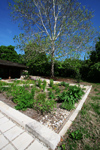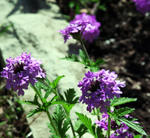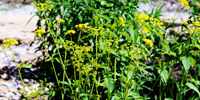K-STATE RAIN GARDEN EARNS LANDSCAPE ARCHITECTURE PROFESSOR DESIGN AWARDS
by Andy Badeker
 A perennial garden at Kansas State University designed to absorb runoff from storms has earned recognition from two landscape architecture organizations.
A perennial garden at Kansas State University designed to absorb runoff from storms has earned recognition from two landscape architecture organizations.
The Prairie Gateway Chapter of the American Society of Landscape Architects presented Lee R. Skabelund, assistant professor of landscape architecture at K-State's College of Architecture, Planning and Design, with a 2008 award of excellence for his work on the project. The society's Central States Conference also has recognized Skabelund with a 2008 award of merit in the built-design category.
Skabelund, who chairs K-State's green building committee, led the group of students, faculty and staff who created the International Student Center's rain garden in 2007.
"The rain garden highlights ways to reduce storm-water runoff and improve the water quality of local streams," Skabelund said. With the help of students and faculty, including Cary Thomsen, a 2007 master's graduate in landscape architecture, and Dennis Day, a professor of landscape architecture, Skabelund created two permeable pathways and a "level-spreader" to slow and temporarily hold runoff.
"We also collected rooftop and surface runoff to re-use in the garden, which is planted with numerous perennials native to the Flint Hills and the central U.S.," Skabelund said.
Skabelund's coordination of the project began in 2006 with a planning and design charrette that involved about 125 students, faculty and staff as well as landscape architecture and engineering professionals.
"That intensive event provided the analytical and creative foundation for the subsequent design and implementation," Skabelund said. About 60 students, faculty members and volunteers began construction in March 2007. It was completed in June 2007.
"In addition to improving water quality and stream-bank stability along Campus Creek, we wanted students and others involved to deepen their understanding of natural and human systems," Skabelund said.
"They learned about collaboration between disciplines, as well as cost-effective techniques to create beautiful work," he said.
 The project also aimed to share information about managing storm water with administrators, staff and local community members. Skabelund has created a Web site at http://faculty.capd.ksu.edu/lskab/ to share ideas about the rain garden and other projects.
The project also aimed to share information about managing storm water with administrators, staff and local community members. Skabelund has created a Web site at http://faculty.capd.ksu.edu/lskab/ to share ideas about the rain garden and other projects.
Even on heavy clay soils like those found at K-State's International Student Center, rain gardens can provide habitat for butterflies and other wildlife, reduce soil erosion and decrease pollution of nearby waterways, Skabelund said.
Like any garden, rain gardens require tending. Skabelund coordinates with students and staff from K-State Facilities and the International Student Center to maintain the garden. Stacy Hutchinson, associate professor, and Reid Christianson, a water quality researcher, both with K-State's department of biological and agricultural engineering, are helping develop monitoring protocols for the garden. Skabelund also is working with art students to build rain bowls for the garden.
Each year, the Prairie Gateway Chapter honors outstanding contributions to landscape architecture from members in Kansas and Missouri. This year's submissions were judged by architects, landscape architects, planners and artists from the society's Wisconsin chapter. The awards were presented April 12 in Wichita.
The Central States Conference awards program recognizes outstanding work by professionals and students in Iowa, Kansas, Missouri, Nebraska, North Dakota, Oklahoma and South Dakota. This year's submissions were judged by architects, landscape architects, planners and artists from the American Society of Landscape Architects' Connecticut chapter. The awards were presented April 23 in St. Louis, Mo.
 Funding for the project's various stages came from the Kansas Department of Health and Environment, the federal Environmental Protection Agency and WaterLINK, a Campus Compact service learning program.
Funding for the project's various stages came from the Kansas Department of Health and Environment, the federal Environmental Protection Agency and WaterLINK, a Campus Compact service learning program.
Material and in-kind support came from the Civitas Group, Atwood Rentals, Bayer Stone, Higgins Stone, Midwest Materials & Concrete, Coonrod Construction, Bayer Construction, Blueville Nursery, Horticultural Services, Three Rivers Engraving, Applied Ecological Services/Kaw River Restoration Nurseries, CritSite Prairie and Wetland Nursery, and Bluebird Nursery.